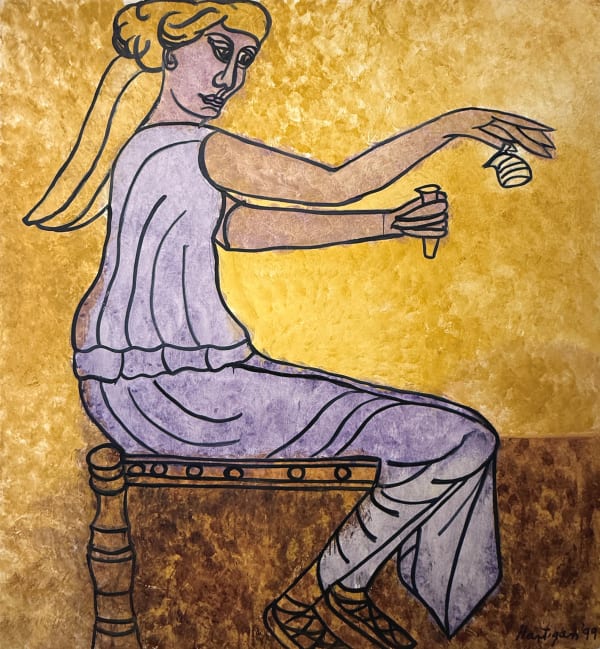Grace Hartigan’s career began among the New York School artists of the 1940s and 1950s after she left her birthplace of Newark, NJ where she studied mechanical drafting as well as painting under Isaac Lane Muse. She befriended and was accepted among established Abstract Expressionists such as Jackson Pollock, Willem de Kooning, Larry Rivers, and poet Frank O’Hara. While she subscribed to the popular mode of painterly expression and the visibility of the artist’s hand, her work extends beyond the individual. Her later works employ both popular culture and art historical references (Hartigan made a conscious decision in 1952 to paint studies after the Old Masters) in a way that helped her paintings resonate with contemporary American life, particularly that of her own locale in the East Village. For Hartigan, abstraction and figuration were not mutually exclusive; pictorial structures in her work are vehicles for emotion, and are handled in a painterly, expressionist manner.
It is for her bold stylistic experimentation that Hartigan is best known. Her brushstrokes are gestural, exude a sense of urgency, and create dramatic lines filled with washes of opulent color, culminating in lyric compositions that dance across the surface of the canvas. Her works from the 1960s take an organic, curvilinear form, while later works from the 1970s are distinctly more figural, showcasing a collection of invented symbols reflecting her interest in mythological subjects.
During the 1950s the Tibor de Nagy Gallery, a spot known as a salon of sorts for the New York School, hosted seven solo exhibitions of Hartigan’s work. She was selected in 1950 for the New Talent exhibition organized by influential critics Clement Greenberg and Meyer Schapiro at another prominent mid-century gallery, the Samuel Kootz Gallery. She was the only woman artist included in The Museum of Modern Art’s international exhibition The New American Painting, which traveled from New York City across Europe between 1958 and 1959. Her paintings and biography were additionally featured in Life magazine and Newsweek at the end of the decade.
A rejection of Abstract Expressionism and the subsequent shift in favor toward Pop and Minimalist styles during the 1960s motivated Hartigan to seek out what she considered to be a less creatively limiting environment. She relocated to Baltimore, Maryland where her career only continued to thrive. She was appointed Director of the Graduate Hoffberger School of Painting at the Maryland Institute College of Art, and gained representation by the C. Grimaldis Gallery, which remains her primary representation after her death in 2008. Six colleges and universities across Maryland and Pennsylvania selected Hartigan to receive honorary degrees. She is also the recipient of numerous additional awards and honors including the Lifetime Achievement Award (Neuberger Museum, 2002) and the Governor’s Award (Baltimore, MA 2006).
Hartigan’s legacy is significant not only in her contribution to the development of American painting, but also as an example of a strong and independent female influence on the mid-century New York art scene. Her career allows art historians today the opportunity to reconsider a generation and artistic era often defined in narrow, patriarchal terms. Her talent did not go unrecognized despite the overwhelming attention given to her male contemporaries. She was able to embrace and contribute to the evolution of Abstract Expressionism while also maintaining a sense of what distinguished her oeuvre, ultimately positioning it to remain relevant in the latter decades of the twentieth century. Her re-introduction of figurative representation, interpreted in a painterly manner rather than necessarily striving for an antiquated sense of realism, paved the way for the New Figuration and Neo-Expressionist artists of the 1970s and 1980s.



